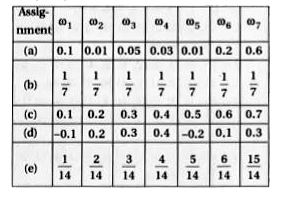Two dice are thrown. The events A, B and C are as follows :
A : getting an even number on the first die.
B : getting an odd number on the first die.
C : getting the sum of the numbers on the dice ≤ 5.
Describe the events
(i) A' (ii) not B (iii) A or B
(iv) A and B (v) A but not C (vi) B or C
(vii) B and C (viii) A'∩B'∩C'Solution in Gujrati
Step by step video & image solution for Two dice are thrown. The events A, B and C are as follows : A : getting an even number on the first die. B : getting an odd number on the first die. C : getting the sum of the numbers on the dice le 5. Describe the events (i) A' (ii) not B (iii) A or B (iv) A and B (v) A but not C (vi) B or C (vii) B and C (viii) A'nnB'nnC' by Maths experts to help you in doubts & scoring excellent marks in Class 11 exams.
Updated on:21/07/2023Topper's Solved these Questions
- PROBABILITYBOOK - NCERT GUJARATICHAPTER - PROBABILITYEXERCISE - EXERCISE 16.3
21 Videos
- PROBABILITYBOOK - NCERT GUJARATICHAPTER - PROBABILITYEXERCISE - MISCELLANEOUS EXERCISEON CHAPTER 16
1 Videos
- PROBABILITYBOOK - NCERT GUJARATICHAPTER - PROBABILITYEXERCISE - EXERCISE 16.1
16 Videos
- PRINCIPLE OF MATHEMATICAL INDUCTIONBOOK - NCERT GUJARATICHAPTER - PRINCIPLE OF MATHEMATICAL INDUCTIONEXERCISE - EXERCISE - 4.1
24 Videos
- RELATIONS AND FUNCTIONSBOOK - NCERT GUJARATICHAPTER - RELATIONS AND FUNCTIONSEXERCISE - Miscellaneous Exercise on Chapter 2
12 Videos
Similar Questions
Which of the following can not be valid assignment of probabilities for outcomes of sample Space S={ω1,ω2,ω3,ω4,ω5,ω6,ω7}

View SolutionA box contains 10 red marbles, 20 blue marbles and 30 green marbles. 5 marbles are drawn from the box, what is the probability that
(i) all will be blue ?
(ii) at least one will be green ?
View Solution1 to 7, describe the sample space for the indicated experiment. A coin is tossed three items.
View SolutionProve the following by using the principle of mathematical induction for all n∈N
1+3+32+…………+3n−1=3n−12
View SolutionThe relation f is defined by f(x)={x20≤x≤33x3≤x≤10
The relation g is defined by g(x)={x20≤x≤23x2≤x≤10
Show that f is a function and g is not a function.
View Solutionदो पासे फेंके जाते है । घटनाएँ निम्न प्रकार से है :
A: पहले पासे पर सम संख्या प्राप्त होना ।
B: पहले पासे पर विषम संख्या प्राप्त होना ।
C:पासो पर प्राप्त संख्याओं का योग ≤5 होना
घटनाओ का वर्णन कीजिए :
B-नहीं
View Solutionदो पासे फेंके जाते है । घटनाएँ निम्न प्रकार से है :
A: पहले पासे पर सम संख्या प्राप्त होना ।
B: पहले पासे पर विषम संख्या प्राप्त होना ।
C:पासो पर प्राप्त संख्याओं का योग ≤5 होना
घटनाओ का वर्णन कीजिए :
A या B
View Solutionदो पासे फेंके जाते है । घटनाएँ निम्न प्रकार से है :
A: पहले पासे पर सम संख्या प्राप्त होना ।
B: पहले पासे पर विषम संख्या प्राप्त होना ।
C:पासो पर प्राप्त संख्याओं का योग ≤5 होना
घटनाओ का वर्णन कीजिए :
B या C
View Solutionदो पासे फेंके जाते है । घटनाएँ निम्न प्रकार से है :
A: पहले पासे पर सम संख्या प्राप्त होना ।
B: पहले पासे पर विषम संख्या प्राप्त होना ।
C:पासो पर प्राप्त संख्याओं का योग ≤5 होना
घटनाओ का वर्णन कीजिए :
B और C
View SolutionTwo dice are throw , the events A, B and C are as follows
A: getting an even number on the first die
B : getting an odd number on the first die
C : getting the sum of the numbers on the dice <= 15
Describe the events
View SolutionTwo dice are thrown. The events A,B and C are as follows:
A: getting an even number on the first die.
B: getting an odd number on the first die.
C: getting sum of the numbers on the dice ≤5.
Describe the events.
View SolutionTwo dice are thrown. The events A, B and C are as follows: A: getting an even number on the first die. B: getting an odd number on the first die. C: getting the sum of the numbers on the dice ≤5.Describe the event:- A'
View SolutionTwo dice are thrown. The events A, B and C are as follows: A: getting an even number on the first die. B: getting an odd number on the first die. C: getting the sum of the numbers on the dice ≤5.Describe the event:- not B
View SolutionTwo dice are thrown. The events A, B and C are as follows: A: getting an even number on the first die. B: getting an odd number on the first die. C: getting the sum of the numbers on the dice ≤5.Describe the event:- A or B
View SolutionTwo dice are thrown. The events A, B and C are as follows: A: getting an even number on the first die. B: getting an odd number on the first die. C: getting the sum of the numbers on the dice ≤5.Describe the event:- A and B
View SolutionTwo dice are thrown. The events A, B and C are as follows: A: getting an even number on the first die. B: getting an odd number on the first die. C: getting the sum of the numbers on the dice ≤5.Describe the event:- A but not C
View Solution
